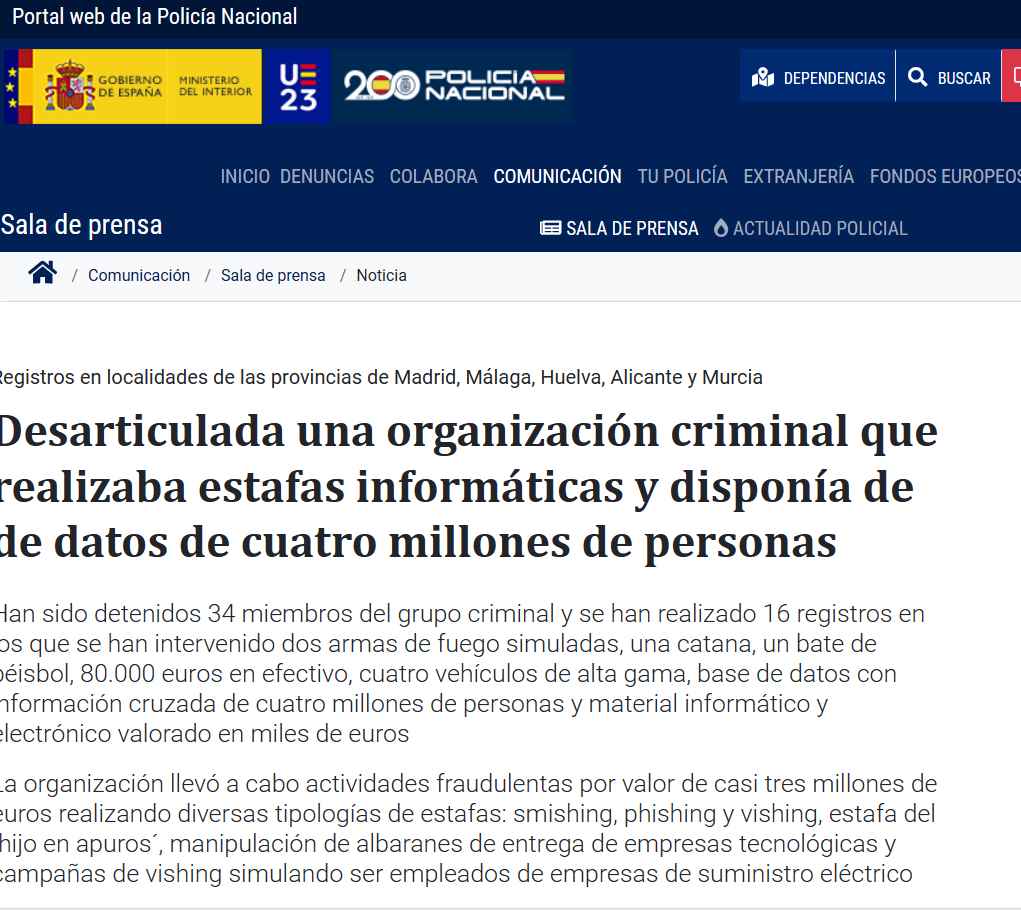The Spanish National Police have successfully dismantled a sophisticated cybercriminal organization, resulting in the arrest of 34 individuals. This organization was involved in a multitude of computer scams, ultimately stealing and monetizing the data of over four million people. The police conducted targeted searches across various cities, including Madrid, Malaga, Huelva, Alicante, and Murcia, leading to significant confiscations, including firearms, luxury cars, and cash.
The criminals engaged in various fraudulent activities such as email and SMS phishing, impersonating delivery firms and electricity suppliers, and executing ‘son in distress’ scams where they manipulated parents into believing their child was in imminent danger, compelling them to send money. The group also exploited insider positions within international tech firms to reroute merchandise to addresses under their control.

A notable strategy employed by the criminals involved breaching the databases of financial and credit institutions. They manipulated account balances and then contacted customers, informing them of a supposed computer error that resulted in an additional loan amount in their accounts, which they were obliged to repay. This led victims to phishing sites where they unknowingly divulged sensitive information.
Financial Trail
The illicit profits, estimated to be around €3,000,000 ($3.2 million), were primarily obtained from reselling the stolen data to other cybercriminals. The organization’s leaders funneled these proceeds into cryptocurrency asset investment platforms, making the financial trail challenging to trace. The police have managed to incarcerate the identified leaders of this cybercrime ring, and continuous efforts are underway to identify more perpetrators and victims.
Questions and Insights
- Diversity of Scams: How did the varied nature of the scams, ranging from phishing to exploiting insider positions, contribute to the success and longevity of the criminal organization? The diversity of scams allowed the criminal organization to target a broader range of victims and operate more stealthily. By not limiting themselves to a single type of scam, they could avoid raising immediate suspicions and detection from law enforcement and cybersecurity experts. Different scams also enabled them to exploit various vulnerabilities in systems and human behaviors, maximizing their chances of success.
- Financial Manipulation: What mechanisms did the criminals employ to manipulate the databases of financial institutions, and how did this facilitate their scams? The criminals breached the databases of financial and credit institutions, gaining unauthorized access to customer data and account balances. They used this access to credit amounts of money to customer accounts falsely, creating a semblance of a computer error. This manipulation allowed them to contact the victims, posing as representatives of the financial institutions, and guide them to phishing sites where sensitive details were harvested.
- Cryptocurrency and Obfuscation: How did the use of cryptocurrency investment platforms aid the criminals in obscuring the financial trails of their illicit profits? Cryptocurrency investment platforms helped the criminals launder their illicit gains by obfuscating the money trail. Cryptocurrencies, by their nature, offer a degree of anonymity and are harder to trace compared to traditional financial transactions. By investing the stolen funds into cryptocurrencies, the criminals could make the origins of the money more ambiguous, complicating law enforcement efforts to trace and recover the stolen funds.
The extensive operation to apprehend these cybercriminals involved 16 targeted searches across the mentioned regions, underscoring the significant resources deployed by the Spanish authorities to curb cybercrime and protect individuals’ data privacy.
This incident reflects a growing concern over cybercrime activities globally and underscores the collaborative efforts by law enforcement agencies to dismantle such criminal organizations, ensuring the safety and security of digital assets and personal information of citizens.
Information security specialist, currently working as risk infrastructure specialist & investigator.
15 years of experience in risk and control process, security audit support, business continuity design and support, workgroup management and information security standards.
